SUBJECTS
GRADE
Show Results
Paiute Federal Recognition and Sovereignty
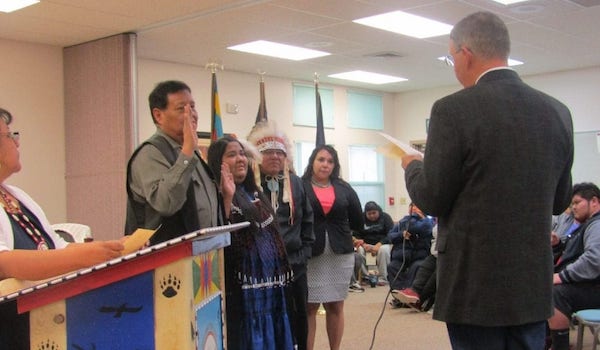
Lesson Summary
- Explore the history of the Paiute Indian Tribe of Utah, through choral reading and process drama activities.
- Explore losing and regaining federal recognition.
- Work in collaborative groups to problem solve, create, and perform.
Lesson Plan and Procedure
Lesson Key Facts
- Grade(s): 4, 5, 6, 7
- Subject(s): Drama, English Language Arts, Social Studies, Native American, Tribe Approved
- Duration of lesson: Two 30-minute sessions
- Author(s): Dorena Martineau, Emily Soderborg, Haley Flanders Anderson, and Yvette Ward May
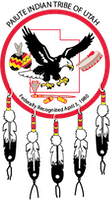
This lesson was written in partnership with Dorena Martineau, the Paiute Cultural Resource Director, and was approved by the Paiute Indian Tribe of Utah’s Tribal Council. Before teaching this lesson, please explain to your students that there are many Indigenous tribes in the United States and that this lesson specifically focuses on the five bands of the Paiute Indian Tribe of Utah and does not represent other Native American groups. It is the hope of the Paiutes that other native tribes will respect their choice to share these aspects of their history and culture.
Note: If you plan to split this into two 30-minute sessions, an appropriate breaking point is after the choral reading and class discussion.
Upload Slide Presentation
Information for the Teacher: The purpose of this warm-up activity is to involve the children in small-group problem solving and working together, while maintaining connection.
Untangling the human knot cannot be done by force. Everyone must collaborate. All individuals need to contribute and help to complete the task.
This activity is chosen to help the children make simple symbolic connection with The Paiute Indian Tribe of Utah, and each of the five bands, as they worked together for survival and maintained their ancestral identity amidst great change associated with new settlers, loss of resources, diminished territory, and National Government rulings, against, and for them. Obtaining federal recognition and gaining sovereignty required many years of holding on with courage and determined effort. Refer to the qualities of resilience, strength, and enduring tribal relationships through-out the lesson.
Warm-up Activity:
Invite students to form a large circle, standing shoulder to shoulder. Invite them all to link elbows as one large, united group. Invite them to look around the circle and see each member of their class. (This is meant to be symbolic of the entire tribe, together, unified as Paiute)
Divide the students up into five smaller groups, assign each group a number 1-5.
Assign a space for each group to do the following activity:
Instructions: Play the human knot game: When all of the groups become untangled invite them to join again into one large circle and link elbows. (Symbolically representing the sovereign Paiute Indian Tribe of Utah)
Emphasize the importance of working together to problem-solve, always stay connected, and untangle their knot.
Class Discussion: Keep it brief. Possible questions:
1. How were you able to get your group untangled, while still holding hands?
2. What did you have to do? How did you work together?
3. What was hard about this game? What was easy?
4. Why is it important to collaborate and problem solve, without being commanding and forceful?
Teacher: The 5 numbered groups you participated in represented five bands who belong to the larger tribe called The Paiute Indian Tribe of Utah. When we stood and linked arms together as a full class, we represented the five bands coming together as the Paiute Indian Tribe of Utah.
What do you think is the difference between a tribe and a band? (A band is a much smaller group of people, mostly related. In comparison, a tribe is a larger group, sometimes comprised of smaller bands, which share a language along with basic customs and beliefs.)
Teacher: Let’s learn more about the five bands and how they came to be from Karma Tillahosh Grayman. Karma is a citizen of the Paiute Indian Tribe of Utah. She is a member of the Shivwits Band. She is teaching Paiute children in this video.
Slide 1: Map and Video
Point to the corresponding towns as you watch Karma Grayman share how the five bands came to be. (Video plays from 18:20-20:30. The entire video can be found in the resource links at the end of the lesson)
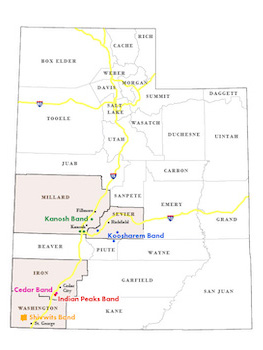
Teacher: The Southern Paiute traditionally call themselves “Nungwu,” (NOONG-WOO) meaning “the people.
You all began as numbered groups, but for the rest of the lesson, each group will be given a special name and purpose, each representing one of the five bands.
Assign each numbered group a representative band name. Invite students to repeat and remember the name of their representative Band (1-Shivwits Band, 2-Cedar Band, 3-Kanosh Band, 4-Koosharem Band, and 5-Indian Peaks Band). They will be together in those same Bands for other parts of the lesson.
Refer to Karma’s video pronunciation and see this phonetic pronunciation guide for the Paiute band names.
Introduction
Teacher: Through the centuries these Bands have lived and worked together in long held ancestral and tribal relationships. They share a common language, customs, and beliefs. In a small symbolic way, your effort to keep holding hands with your classmates as you worked together to untangle yourselves, can be likened to many years of work by the five bands to keep and preserve their rich ancestral heritage and personal freedoms. Ongoing effort to keep these vital connections has been essential to the survival and strength of the Paiute communities to the present-day. These relationships have played an important part in their history as a tribe. The Paiute Indian Tribe of Utah is one of 8 Sovereign Nations within the state of Utah.
Slide 2: Map of Utah, Ancestral Lands of the Five Sovereign Nations.
Teacher: This map is a depiction of the ancestral lands of the five Sovereign Nations in the state of Utah. Ancestral lands refer to the territory once occupied by these indigenous tribes.
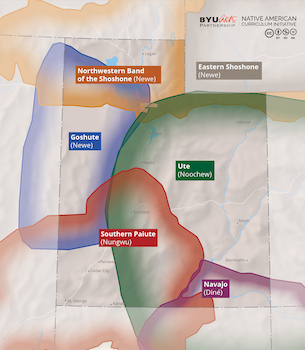
Teacher: Here is a view of the five band’s reservation territory today. What do you notice?
Slide 3: Modern reservation Map
Activity: Choral Reading
A choral reading is an interpretive reading of text by a group of voices.
- Students may read individual lines or stanzas alone, in groups or in unison as a whole class.
- For younger students, the teacher may want to do the initial read-through, as students follow along. This will set the pace and model proper pronunciation, and dramatic expression for students as they listen.
- For more mature students, do an initial read-through/rehearsal in their small groups.
Note: See the phonetic pronunciation guide for the Paiute band names. This guide is also included at the end of the choral reading.
Teacher: Let’s learn more of the history of the Paiute Indian Tribe of Utah, by performing a choral reading together. Quickly gather into the same groups as you were for our ‘human knot’ activity. Sit/stand with your group and we’ll combine to make a full-class circle. Your individual Bands will be the numbered groups in the choral reading and the solo readers will be five individual narrators, one selected from each numbered group.
(1-Shivwits Band, 2-Cedar Band, 3-Kanosh Band, 4-Koosharem Band, and 5-Indian Peaks Band)
Pass out the Choral Reading Script: Paiute Recognition and Sovereignty to each student. Have each group choose their narrator, or select a narrator from each group yourself.
Teacher: As we read through the script, think about how the five Paiute Bands worked together to overcome their problems. What did they do together to navigate the difficulties they faced?
Do a full class quality-performance read-through of the script.
Following the completion of the script read-through. Lead a class discussion. Select from the following questions, or ask your own.
Teacher:
- What are your initial thoughts or feelings about what we read?
- What did the Paiutes do to navigate the difficulties they faced?
- How did the five Paiute Bands work together to overcome their problems?
- What did you learn?
- What will you remember about this lesson?
- What is the importance of learning history from multiple perspectives?
- How do the arts help bring history to life and make it more personally meaningful for you?
- How could aspects of Paiute history and resilience connect with the “untying the knot” activity we began with today?
Option: Continue the lesson from here to the end, or conclude by letting the students know you will learn more about Paiute history, using some process drama activities, in another session.
If ending here, express appreciation to the students for their participation, and express specific recognition for their contributions, insights, and sharing.
Session Two:
Process Drama Instruction:
Invite students to work in their same five groups-bands, as in the previous session activities.
Teacher: Let’s continue our exploration of the history of The Paiute Indian Tribe of Utah’s. Has anyone heard of process drama? Process drama is pretending to be in the world or in the scenario of what we are studying. Based on the instructions I give, you will see or read an image on a slide, and have the opportunity to improvise acting as the people, places, and things in that environment. There are no scripts. It is all simply a creative process to explore each setting or scenario, using body movement, voice, and imagination. In a way it’s like creating living history. Let’s begin.
Teacher: Each group will receive a paper with your Paiute band name and the band’s logo or seal, including a brief description of its meaning. As a group, decide how you will represent the logo and then work together to create a tableau representing your band’s seal. A tableau is a still image made with your bodies, like a frozen sculpture.
Teacher: When it’s time for sharing, a member of your group will introduce your band and read the description aloud. Then you will have the opportunity to present your tableau. Each group will have a turn.
Invite students to sit in their five groups. Hand each group one description paper for either the Cedar, Kanosh, Koosharem, Indian Peaks, and Shivwits band (print and pass out Paiute Seals and Logos for Tableaus ). Give them 5-10 minutes to read the information, discuss, design, and practice making their tableau. Gather the class together and have them continue to sit in their bands as the groups perform for each other. As each band performs, display the accompanying slide:
Slide 4: Cedar Band Seal
Slide 5: Kanosh Band logo
Slide 6: Koosharem Band Seal
Slide 7: Shivwits Band Seal
Slide 8: Indian Peaks Band Seal
Activity/Performance:
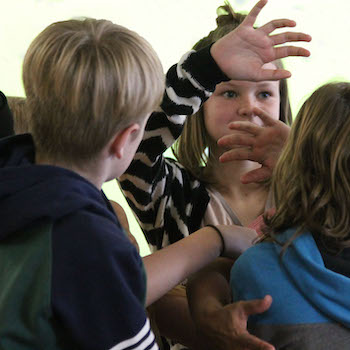
Teacher: Now, we will perform three more process drama
activities that will help us gain understanding of the timeline that the Paiute people took to gain federal sovereignty and recognition. Each band will take a turn. Continue to sit with your bands and I will call on your band when it is your turn to participate.
Activity 1: Creating a Place
Note: During this activity, you can use Paiute flute music to underscore the students’ acting and add depth to their experience. Little Sun in the Blue Sky by Shanan Martineau is an approved Paiute album and can be found on YouTube. You could also use nature sounds, water flowing, desert soundscape, and so on.)
Teacher: Our first activity is called “Creating a Place.” To better understand the Paiute people, we are going to represent aspects of their ancestral tribal ways in southwestern Utah before westerners arrived, and then when settlers began to come onto their land. As you silently improvise creating these settings together, I will simultaneously share facts.
Slide 9: Paiute Ancestral Home: Wickiup, Kahn
Teacher: Indian Peaks Band, please stand where you are. Look at this image, and improvise creating this scene, as I read.
Many Paiute Indians lived in wickiups. The Paiutes called them kahns (IPA “kɑːnz”), their word for home. Wickiups are small round or cone-shaped houses made of a willow frame and covered with brush. At times they also used tipis. Because they moved frequently from place to place as they hunted and gathered food and resources, they needed homes that were portable or easy to build. Within the bands, the Paiutes lived in independent groups of three to five households or about 15-30 people.
Thank you, Indian Peaks. You may be seated.
Slide 10: Paiute Irrigation Gardening
Teacher: Cedar Band, please stand where you are. Look at this image, and improvise creating this scene, as I read.
“Paa” means water and “ute” references that they were part of the Ute family of tribes, so the name Paiute refers to their preference for living near water sources. During spring, in the valleys to the west and south of Cedar Breaks, the Southern Paiute practiced floodplain gardening, creating reservoirs and irrigation ditches to water corn, squash, melons, gourds, sunflowers, beans, and wheat.
Thank you, Cedar Band. You may be seated.
Slide 11: Nomadic Hunters and Gatherers
Teacher: Koosharem Band, please stand where you are. Look at this image, and improvise creating this scene, as I read.
The Paiute traveled to various areas throughout the year to harvest food and natural materials in the appropriate seasons. After planting their fields in the spring, the Paiute often journeyed high up to the meadows and forests of the surrounding plateaus. Here, the Paiute hunted mule deer, elk, bighorn sheep, antelope, woodchucks, rabbits, and gathered berries and plants.
Thank you, Koosharem Band. You may be seated.
Slide 12: Settlements near Paiute Water Sources
Teacher: Kanosh Band, please stand where you are. Look at this image, and improvise creating this scene, as I read.
As you are farming, hunting, and gathering, others, such as the Mormon pioneers, are building Westernized settlements on your land. What was it like to greet the newcomers to your land? These new settlements rapidly brought an end to the Paiute’s traditional way of life since these settlements were built on vital Paiute hunting and gathering grounds. How would you react to being denied access to water sources and losing your crops? Livestock grazing in the surrounding areas destroyed many of the plants that were a staple of the Paiute diet. As a result of these settlements, the only land left to the Paiutes was mostly unfarmable.
Thank you, Kanosh Band. You may be seated.
Slide 13: Maps of ancestral land and reservation land
Teacher: Shivwits Band, please stand where you are. Look at this image, and improvise creating the meaning of this scene, as I read.
The Paiute people’s original homeland spanned more than thirty million acres. As western settlements grew, the Paiutes were gradually moved and confined to an area 100 times smaller than their traditional homelands. The first Paiute reservation was established in 1891 on the Santa Clara River west of St. George and was federally recognized in 1903. After this, three other Paiute reservations were created. With these reservations, the tribes at least had their own lands again and tribal sovereignty. Show what it must have been like for them to maintain their culture and way of life inside such a small, confined area?
Thank you, Shivwits Band. You may be seated.
Activity 2: Soundscape
Teacher: Continuing with the Paiute timeline, after white settlements were built and reservations were created, there came more hardship for the Paiutes. We will explore aspects of three periods: early reservation, termination, and restoration using a process drama activity called soundscape.
Slide 14: Early Reservation, Termination, and Restoration
Teacher: In a soundscape, we can only use our voices or the sounds our bodies can make to create the sounds expressed in a specific location or event in time. As you make sounds, listen to your group. Add new sounds or shift your sound to explore all possible aspects of place. You could also use short phrases of spoken text in addition to sounds. All bands will stay where they are. I will call on each band to begin making the soundscape. Each band will perform three times.
Slide 15: Round 1: Early Reservations
Slide 16: Weaving
Teacher:
- Indian Peaks Band: The sounds of hand-weaving plant fibers into finely crafted baskets that could be used to carry food and water.
Slide 17: Arrowhead
- Cedar Band: The sounds of chipping agate rock to make stone tools, such as arrowheads and spear points.
Slide 18: Book in English
- Koosharem Band: The sounds of bilingual people learning to read and write in English while also maintaining their Paiute culture.
Slide 19: Digging Irrigation
- Kanosh Band: The sounds of building irrigation systems to increase farming.
Slide 20: Tribal Council
- Shivwits Band: The sounds of establishing their band’s own constitution and tribal council.
Slide 21: Round 2: Termination:
Teacher:
Slide 22: Pay taxes. No jobs.
- Indian Peaks Band: The sounds of Southern Paiutes asking questions about how to pay taxes without jobs.
Slide 23: Dying for healthcare
- Cedar Band: The sounds of mourning as many Southern Paiutes were dying from lack of healthcare resources.
Slide 24: Telegram and Telegraph
- Koosharem Band: The sound of a telegraph message being sent to Washington D.C. expressing the desire to not be terminated.
Slide 25: Termination. Farming efforts useless
- Kanosh Band: The sounds of frustration when termination made their farming efforts useless.
Slide 26: No longer considered Indian?
- Shivwits Band: The sounds of former tribal councils and tribal members questioning their role and identity now that they were no longer considered Indian.
Slide 27: Round 3: Restoration
Teacher:
Slide 28: Petition to gain recognition
- Indian Peaks Band: The sounds of petitioning Congress for nearly ten years to gain federal recognition as one combined tribe.
Slide 29: Receive federal recognition
- Cedar Band: The sounds of the tribe finding out in 1980 that they received federal recognition once again due to Congress’ “Paiute Reservation Plan.”
Slide 30: Hold a meeting
- Koosharem Band: The sound of a newly organized Paiute Indian Tribe of Utah, PITU, Tribal Council holding a meeting to discuss important issues regarding their people and lands.
Slide 31: Healthcare building
- Kanosh Band: The sounds of Paiute people accessing newly built healthcare facilities on or near each band’s reservation
Slide 32: Paid Tuition
- Shivwits Band: The sound of again being eligible for college tuition and other assistance so education could be pursued.
Class Discussion:
Possible Questions:
- What was this experience like? What was easy? What was challenging?
- What was your favorite sound to listen to and why?
- How did making the soundscape help you picture the setting and these important moments in Paiute history?
- What were the feelings you had when you performed Round 1 (Early Reservations)? Round 2 (Termination)? Round 3 (Restoration)?
Activity 3: Class Tableau
Teacher: As we explored the restoration phase of Paiute history, we showed the tribal nation’s restored sovereignty. They were able to govern themselves through their recognized tribal council. The separate bands joined together to create the unified Paiute Indian Tribe of Utah.
Slide 33: Paiute Indian Tribe of Utah logo.
Teacher: We will now create an entire class tableau. This won’t be a tableau of the Paiute Indian Tribe of Utah logo, but will instead show how the Paiute people felt as they were again granted federal recognition. To do this, physically move together and create a frozen picture symbolizing the individual bands joining together to form one federally recognized tribe. Decide your actions based on the feelings the Paiute people might have felt at this time. All bands will need to work together and be ready to create the tableau in fifteen seconds.
Select an area of the room, where the full class can come together to create this tableau. Use the beat of a drum, or count slowly from 1-15, as students move into position. Provide instructions for using high-low levels, full body movements, showing resistance and strength, as they move together into a final position.
Activity 4: Role on the Wall
Have the students gather on the floor.
Teacher: Our final activity is called “Role on the Wall.” On the whiteboard, I am going to draw (or display Slide 34) an outline of the state of Utah. Take a few minutes to silently think about why you feel it is important for Southern Paiute history to be taught as a part of Utah history. How does it benefit your knowledge, understanding, and appreciation for the people of Utah? How have the activities and drama experiences from today created meaning for you?
Pass out sticky notes and pencils to each student.
Teacher: Come up with a word or phrase that shares your main take-away from what you have learned about the Paiute Indian Tribe of Utah and why that idea is important for us today. Write your word or phrase on the sticky note, and then come put your word inside the outline of Utah. Watch how I do my own example.
Model writing on and placing sticky note within the Utah outline on the board.
Give the students a few minutes to brainstorm and write on their sticky notes and attach them to the board. Then give the class time to read what each individual wrote inside the outline of Utah. Have the students sit down for the concluding discussion.
Conclusion
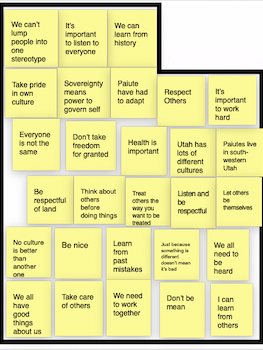
Possible questions for discussion:
Teacher:
- What are your observations about what other students wrote on the wall?
- Because of the determined efforts of The Paiute Indian Tribe of Utah, they have federal recognition once again. But does having federal recognition mean that everything is perfect and easy for the Paiutes? Why or why not?
- When we started learning about The Paiute Indian Tribe of Utah, we played a game, “untying the human knot”, with five different groups. Those same groups also represented the five bands within the Paiute Indian Tribe of Utah. We explored their history with choral reading, creating soundscapes, and tableau, etc. We made a drama-based-living history journey, learning about how they worked together to solve difficult problems regarding their homelands, government, and survival. How did the process drama activities–Tableau, Creating a Place, Soundscape, and Role on the Wall–help you better understand and relate to these real experiences, both in the past and present, of the Paiute people?
- Did it work to combine drama activities with learning this important history? Why? How? Why not?
- How might these activities and knowledge affect you in the future?
- What will you remember most about this experience?
Optional Extension Activity: Use the resources found in “Additional Resources” to further study the history of the Southern Paiute, the geography of the Southwestern United States, or important people and legends in Paiute culture and history. Then have students give reports on their findings, focusing more intently on the specific standards outlined in the Social Studies Core
Learning Objectives
- Understand the relationship between the geography in Utah and human life.
- Understand how Utah's history has been shaped by people, events, and ideas.
- Understand the roles of civic life, politics, and government regarding Utah’s
citizens - Arrange the physical playing space with intent.
- Work effectively in an ensemble.
- Observe, listen, and respond in character.
- Communicate meaning through body and voice.
- Demonstrate appropriate audience skills.
- Explore stories from a variety of cultures, genres, and styles.
- Identify historical, global, and social issues found in a theatre work.
- Refer to details and examples in a text when explaining and drawing inferences.
- Report on a topic and recount an experience using appropriate facts and details to support themes.
Utah State Board of Education Standards
This lesson can be used to meet standards in many grades and subject areas. We will highlight one grade’s standards to give an example of application.
Grade 4 Social Studies
- Standard 4.2.1: Use evidence (for example, artifacts, texts, oral traditions, geographic inquiry) to make inferences about, and explain the importance of, the geography of the land that would become Utah in the culture of one or more prehistoric or historic Native American cultures.
- Standard 4.2.2: Explain the economic concepts of trade, scarcity, and supply and demand. Apply these concepts in analyzing the economic activity of Native American tribal groups that existed during this period in the land now called Utah and their trade with European-American trappers and traders.
- Standard 4.2.3: Use primary and secondary sources to compare important aspects of the ways of life of at least two Native American tribal groups (for example, Ute, Paiute, Navajo (Diné), Shoshone, Goshute) existing existing within the land now called Utah and how those ways of life changed as settlers from Europe arrived prior to 1847.
- Standard 4.3.5: Cite multiple perspectives to explain the historical significance and context of at least one conflict of this period (for example, The Utah War, The Mountain Meadows Massacre, The Bear River Massacre, The Black Hawk War).
- Standard 4.4.5: Analyze the way local, state, tribal, and federal governments interact with one another.
Grade 4 Drama
- Standard 4.T.CR.2: Arrange the physical playing space to communicate mood, time, and locale.
- Standard 4.T.P.2: Demonstrate the ability to work effectively alone and cooperatively, with a partner or in an ensemble.
- Standard 4.T.P.3: Observe, listen, and respond in character to other actors throughout a scripted or improvised scene.
- Standard 4.T.P.4: Communicate meaning using the body through space, shape, energy and gesture.
- Standard 4.T.P.5: Communicate meaning using the voice through volume, pitch, tone, rate, and clarity.
- Standard 4.T.R.1: Demonstrate audience skills of observing attentively and responding appropriately.
- Standard 4.T.CO.2: Read, listen to, and tell stories from a variety of cultures, genres, and styles; identify the characters, setting, plot, theme and conflict in these plays and stories; and identify historical, global, and social issues connecting them through a drama/theatre work.
Grade 4 English Language Arts
- Standard 4.R.5: Refer to details and evidence in a text when explaining what the text says explicitly and when drawing inferences from the text. (RL & RI)
- Standard 4.SL.2: Clearly summarize information presented in various formats and media and explain how the information pertains to the topic.
Equipment and Materials Needed
- Upload slideshow: Paiute Federal Recognition and Sovereignty
- Review Instructions for Play the Human Knot game
- Printed and stapled copies of Choral Reading Script: Paiute Recognition and Sovereignty for each student
- Become familiar with the Paiute Bands Pronunciation Guide
- Print one copy of: Paiute Seals and Logos for Tableaus
- White board and dry erase markers
- Sticky notes and pencils for each individual student
- Optional: Recording of Paiute flute music Little Sun in the Blue Sky, Shanan Martineau
Additional Resources
- Invite an artist from the Utah Department of Arts and Museums Native American Teaching Artist Roster to teach or perform at your school, or in your community.
- Full Video: Karma Grayman Video: Five Paiute Bands
- Resources for information on the Paiute Indian Tribe of Utah: https://www.utahpaiutes.org
- Our History: https://www.utahpaiutes.org/our-history/
- Reservation information: https://www.utahpaiutes.org/reservation/
- Bands: https://www.utahpaiutes.org/bands/
- http://www.nativepartnership.org/site/PageServer?pagename=PWNA_native_history_1930
- https://ilovehistory.utah.gov/paiute/
- https://graftonheritage.org/history-settlement/
- https://www.nps.gov/articles/about-the-southern-paiute.htm
This lesson is supported by the National Endowment of the Arts and the Utah Division of Arts & Museums
Image References
Images 1, 2: The Paiute Indian Tribe of Utah
Images 3, 4: Curtis Soderborg
Image 5: James Huston
Image 6: Emily Soderborg
© Brigham Young University and the Paiute Indian Tribe of Utah

www.education.byu.edu/arts/lessons
 Download
Download